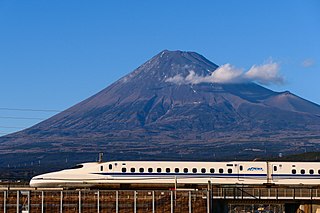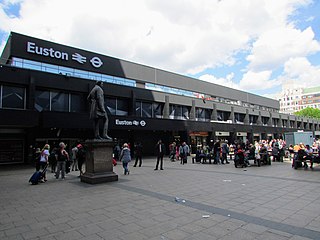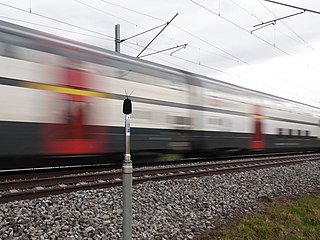
Acoustics is a branch of physics that deals with the study of mechanical waves in gases, liquids, and solids including topics such as vibration, sound, ultrasound and infrasound. A scientist who works in the field of acoustics is an acoustician while someone working in the field of acoustics technology may be called an acoustical engineer. The application of acoustics is present in almost all aspects of modern society with the most obvious being the audio and noise control industries.

High-speed rail (HSR) is a type of rail transport network utilizing trains that run significantly faster than those of traditional rail, using an integrated system of specialized rolling stock and dedicated tracks. While there is no single standard that applies worldwide, lines built to handle speeds above 250 km/h (155 mph) or upgraded lines in excess of 200 km/h (125 mph) are widely considered to be high-speed.

The TGV is France's intercity high-speed rail service. With commercial operating speeds of up to 320 km/h (200 mph) on the newer lines, the TGV was conceived at the same period as other technological projects such as the Ariane 1 rocket and Concorde supersonic airliner; sponsored by the Government of France, those funding programmes were known as champion national policies. In 2023 the TGV network in France carried 122 million passengers.

A seismic wave is a mechanical wave of acoustic energy that travels through the Earth or another planetary body. It can result from an earthquake, volcanic eruption, magma movement, a large landslide and a large man-made explosion that produces low-frequency acoustic energy. Seismic waves are studied by seismologists, who record the waves using seismometers, hydrophones, or accelerometers. Seismic waves are distinguished from seismic noise, which is persistent low-amplitude vibration arising from a variety of natural and anthropogenic sources.

Euston railway station is a major central London railway terminus managed by Network Rail in the London Borough of Camden. It is the southern terminus of the West Coast Main Line, the UK's busiest inter-city railway. Euston is the tenth-busiest station in Britain and the country's busiest inter-city passenger terminal, being the gateway from London to the West Midlands, North West England, North Wales and Scotland.

Train noise is vehicle noise made by trains. Noises may be heard inside the train and outside.

High-speed rail in the United Kingdom is provided on five upgraded railway lines running at top speeds of 125 mph (200 km/h) and one purpose-built high-speed line reaching 186 mph (300 km/h).

The CRH2 Hexie is one of the high-speed train models in China. The CRH2 is based on the E2-1000 Series Shinkansen design from Japan with the license purchased from a consortium formed of Kawasaki Heavy Industries, Mitsubishi Electric, and Hitachi, and represents the second Shinkansen train model to be exported.

UK Ultraspeed was a proposed high-speed magnetic-levitation train line between London and Glasgow, linking 16 stations including Edinburgh, Birmingham, Manchester and Newcastle and six airports. It was rejected in 2007 by the UK government, in favour of conventional high-speed rail. The company behind the proposal ceased efforts to promote it in early 2013.

High Speed 2 (HS2) is a high-speed railway which has been under construction in England since 2017. The line's planned route is between Handsacre, in southern Staffordshire, and London, with a spur to Birmingham. HS2 is to be Britain's second purpose-built high-speed railway after High Speed 1, which connects London to the Channel Tunnel. London and Birmingham are to be served directly by new high speed track. Services to Glasgow, Liverpool and Manchester are to use a mix of new high-speed track and the existing West Coast Main Line. The majority of the project is planned to be completed by 2033.
In fluid dynamics, a Tollmien–Schlichting wave is a streamwise unstable wave which arises in a bounded shear flow. It is one of the more common methods by which a laminar bounded shear flow transitions to turbulence. The waves are initiated when some disturbance interacts with leading edge roughness in a process known as receptivity. These waves are slowly amplified as they move downstream until they may eventually grow large enough that nonlinearities take over and the flow transitions to turbulence.
Piston effect refers to the forced-air flow inside a tunnel or shaft caused by moving vehicles. It is one of numerous phenomena that engineers and designers must consider when developing a range of structures.
Rayleigh waves are a type of surface acoustic wave that travel along the surface of solids. They can be produced in materials in many ways, such as by a localized impact or by piezo-electric transduction, and are frequently used in non-destructive testing for detecting defects. Rayleigh waves are part of the seismic waves that are produced on the Earth by earthquakes. When guided in layers they are referred to as Lamb waves, Rayleigh–Lamb waves, or generalized Rayleigh waves.
In geophysics, geology, civil engineering, and related disciplines, seismic noise is a generic name for a relatively persistent vibration of the ground, due to a multitude of causes, that is often a non-interpretable or unwanted component of signals recorded by seismometers.

The CRH380A Hexie is a Chinese electric high-speed train that was developed by CSR Corporation Limited (CSR) and is currently manufactured by CRRC Qingdao Sifang. As a continuation of the CRH2-380 program it both replaces foreign (Japanese) technology in the CRH2 with Chinese developments and increases its top speed. The CRH380A is designed to operate at a cruise speed of 350 km/h (217 mph) and a maximum speed of 380 km/h (236 mph) in commercial service. The original 8-car train-set recorded a top speed of 416.6 km/h (258.9 mph) during a trial run. The longer 16-car train-set reached 486.1 km/h (302.0 mph).

Victor Krylov is a Russian-born British academic. He is emeritus professor of acoustics and vibration at Loughborough University.
Ground vibrations is a technical term that is being used to describe mostly man-made vibrations of the ground, in contrast to natural vibrations of the Earth studied by seismology. For example, vibrations caused by explosions, construction works, railway and road transport, etc. - all belong to ground vibrations.

The history of High Speed 2 is the background to the planned construction of High Speed 2 (HS2), a new high-speed railway in Great Britain that was originally planned to connect London, Birmingham, Manchester, Leeds and other cities in the UK.
The AeroLiner3000 is a project for the introduction of a double-decker train in the UK, which can run on a large part of the existing British rail network with the tight loading gauge PG1. The train was developed by Andreas Vogler Studio together with the German Aerospace Center. At the InnoTrans 2016 in Berlin, a 9-metre (30 ft) long full-scale demonstrator was presented.

Critical embankment velocity or critical speed, in transportation engineering, is the velocity value of the upper moving vehicle that causes the severe vibration of the embankment and the nearby ground. This concept and the prediction method was put forward by scholars in civil engineering communities before 1980 and stressed and exhaustively studied by Krylov in 1994 based on the Green function method and predicted more accurately using other methods in the following. When the vehicles such as high-speed trains or airplanes move approaching or beyond this critical velocity, the vibration magnitudes of vehicles and nearby ground increase rapidly and possibly lead to the damage to the passengers and the neighboring residents. This relevant unexpected phenomenon is called the ground vibration boom from 1997 when it was observed in Sweden for the first time.














